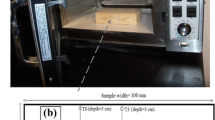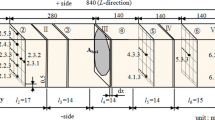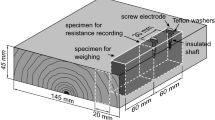Abstract
Drying rates and power densities are determined for pine-and sprucewood when dried from green to 8% moisture content by microwave power. The process is controlled by measurements of internal wood temperature, internal vapour pressure and rate of moisture evaporation. Microwave power densities ranged from 25 to 78 kW/m3, microwave energy consumption from 365 to 760 kWh/m3. Internal wood temperatures up to 140 °C were used. Internal vapour pressure in the wood could rise to about 20 kPa without checking. Maximal drying rates of 0.20 to 0.45% moisture content per minute are possible to obtain when drying above fiber saturation (fsp). Below fsp the feasible drying rates ranged from 0.10 to 0.20% moisture content per minute. Spruce dried approximately 1.6 times faster than pine. No conditioning of the wood was necessary since the wood was free of stresses. The wood was free of checks but colour changes occured in the interior of some specimens.
Zusammenfassung
Trocknungsraten und Energiedichten wurden während der Mikrowellentrocknung von Kiefern-und Fichtenholz bestimmt. Die Trocknung erfolgte vom waldfrischen Zustand zu 8% Gleichgewichtsfeuchte. Meßgrößen ware Holztemperatur und Dampfdruck im Innern der Proben sowie die Verdampfungsrate. Die Energiedichte lag zwischen 25 und 78 kW/m3, der Energieverbrauch schwankte zwischen 365 und 760 kWh/m3. Die Temperatur der Holzproben stieg bis 140 °C. Der Dampfdruck konnte bis etwa 20 kP a ohne Rißbildung ansteigen. Oberhalb des Fasersättigungspunktes konnten Trocknungsraten von 0,20 bis 0,45% pro Minute erreicht werden. Darunter waren nur Raten zwischen 0,1 und 0,2% möglich. Fichtenholz trocknete etwa 1,6 mal rascher als Kiefernholz. Da das Holz spannungsfrei trocknete war keine anschließende Konditionierung nötig. Auch Risse traten nicht auf, wohl aber einige Verfärbungen im Innern einiger Proben.
Similar content being viewed by others
References
Antti, A. L. 1992: Microwave drying of hardwood: simultaneous measurements of pressure, temperature, and weight reduction. Forest Prod. J. 42 (6): 49–54
Barnes D.; Admiraal, L; Pike, R. L.; Mathur, V. N. P. 1976: Continuous system for the drying of lumber with microwave energy. Forest Prod. J. 26 (5): 31–42
Egner, K.; Jagfeld, P. 1964: Versuche zur Künstlichen Trocknung von Holz durch Mikrowellen. Beilage Moderne Holzverarbeitung. October 26: 297–300
McAlister, W. R.; Resch, H 1971: Drying 1-inch ponderosa pine lumber with a combination of microwave power and hot air. Forest Prod. J. 21 (3): 26–34
Metaxas, A. C.; Meredith, R. J. 1983: Industrial microwave heating. Peter Peregrinus Ltd. London, UK
Resch, H. 1968: Über die Holztrocknung mit Mikrowellen. Holz Roh-Werkstoff 26 (9): 317–24
Author information
Authors and Affiliations
Rights and permissions
About this article
Cite this article
Antti, A.L. Microwave drying of pine and spruce. Holz als Roh-und Werkstoff 53, 333–338 (1995). https://doi.org/10.1007/s001070050102
Issue Date:
DOI: https://doi.org/10.1007/s001070050102




